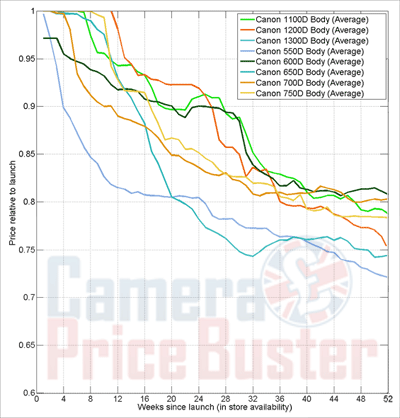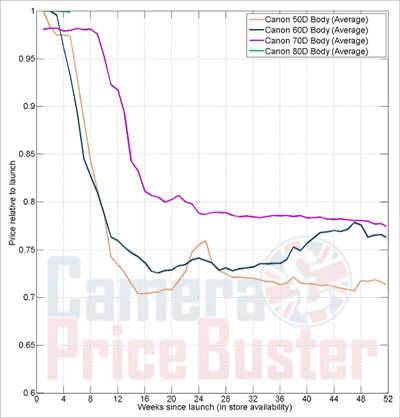I was recently contacted by one of my site visitors, Slobodan Radosavljevic, asking for access to some price history data. He wanted to analyse how the price of certain cameras reduced over time. I was happy to provide the data, and he has kindly sent me back some graphs showing comparisons for the price reductions over time (the price decay) for Canon DSLRs.
These graphs should be useful when judging a good time to buy a relatively new camera. You probably already know that you should not buy the camera straight after (or before, on pre-order) its release, unless you have an urgent need for it. If you do you will end up paying around the RRP. As you can see from the graphs, the price tends to drop fairly quickly after release, and you can make some generalisations about when is a good time to buy.
This is the graph for the “beginner level” Canon DSLR bodies – click the image for a larger version spanning two years:
As you can see, if you had purchased any of these cameras after 52 weeks, you would have been purchasing after most of the significant price drops. If that is too long after release, then the 32 week mark seems a pretty good compromise, and failing that 20 weeks.
This is the graph for the mid range “enthusiast” Canon bodies (click for a larger view):
The trend here is quite different – there are more rapid drops with a sweet spot around 16 weeks. It will be interesting to see if the new 80D follows the same trend, so far it seems to be holding its price higher.
Finally, this is the graph for some of the higher end cameras in the Canon range (click for a larger view):
The original 7D seems to have fallen in price unusually rapidly – perhaps it was a little over priced to start with. There seem to be good buying points around 32 weeks and 42 weeks in general.
I hope you find this data useful. I should state the obvious: there is no guarantee that current and future releases will follow the same trend, this is just meant to give you a rough idea of the sort of price pattern you could expect. Prices are influenced by the availability versus demand – so if all available stock is presold, you can expect the price to remain higher for longer.
You have to weigh up how quickly you need the camera against the price you are willing to pay. Clearly if you need the camera for a specific piece of work, or a holiday etc, then your best bet is to just buy it as late as you think you can get away with. Don’t just wait around for ever hoping the price will keep falling (incidentally, it will probably hit rock bottom just after the camera’s successor is released) or you’ll never actually buy it. My advice is wait until at least 20 weeks have passed from release if you can, and then get the camera at a price you are happy with and enjoy shooting with it.
Thanks to Slobodan Radosavljevic for doing the hard work and turning the raw data into something useful.




Leave a Reply